Long White Gypsy uses affiliate links and is a member of the Amazon Services LLC Associates Program. If you make a purchase using one of these links, I may receive a small commission at no extra cost to you. See my Privacy Policy for more information.
If you’re thinking about checking out the Castle Hill area, you’re in for a treat. This spot is not just another pretty place on the map – it’s like stepping onto another planet with its massive limestone rocks (or tors) and wide-open spaces!
Plus, Castle Hill is rich with cultural history, which just makes the entire experience more intriguing.
Since I moved to Christchurch in mid-2023 I’ve made the most of exploring this wilderness area on a handful of occasions, because it’s just a short 1 hour 2 minute drive from the city outskirts!
In this post I’ll break down the basics of what you need to know if you’re planning on visiting this area, from things to do to the best times to visit, so you can make the most of your trip.
Trust me, this place is worth strapping on your hiking boots for!
Castle Hill New Zealand Things to Do.
Castle Hill offers a variety of activities to cater to every type of traveller.
From rock climbing and bouldering adventures that challenge the body and spirit to tranquil walks amidst the grandeur of the limestone formations, Castle Hill promises to captivate.
Let’s explore what’s on offer in this natural playground.
Kura Tawhiti Access Track
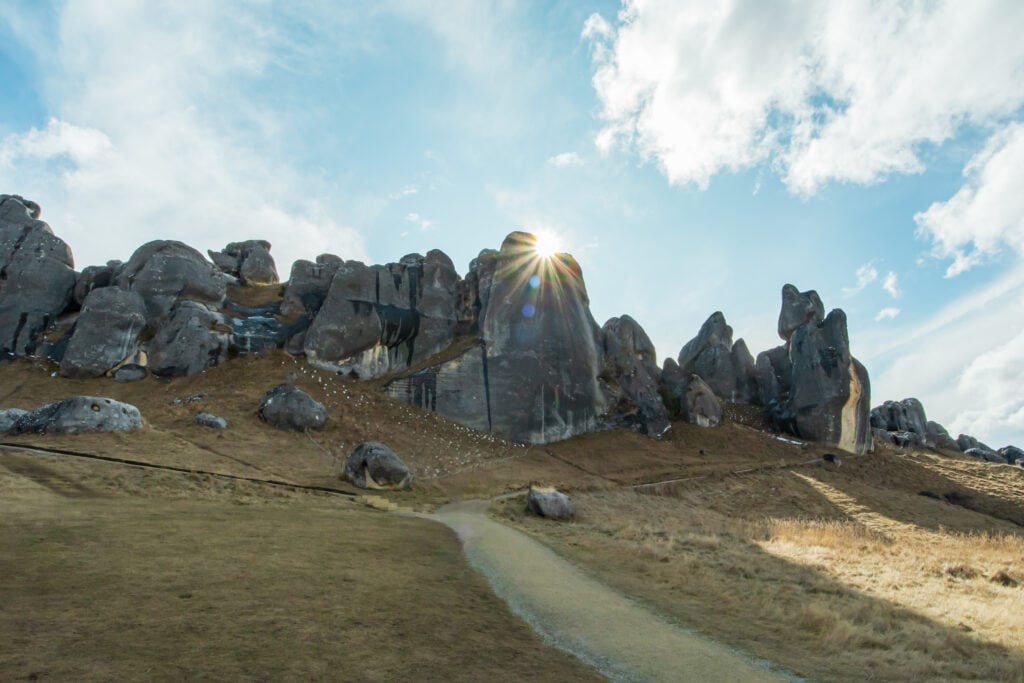
The Kura Tawhiti Access Track is the main pathway to explore the heart of the Castle Hill rocks. This easy-grade walk is approximately 1.5 kilometres / 0.9 miles (40 minutes) on an easy gradient, making it accessible for most people.
It usually takes about an hour to complete the full walk at a leisurely pace, but you can spend much longer here exploring the various formations, nooks and crannies (plus, it’s a great place to bring a picnic lunch!).
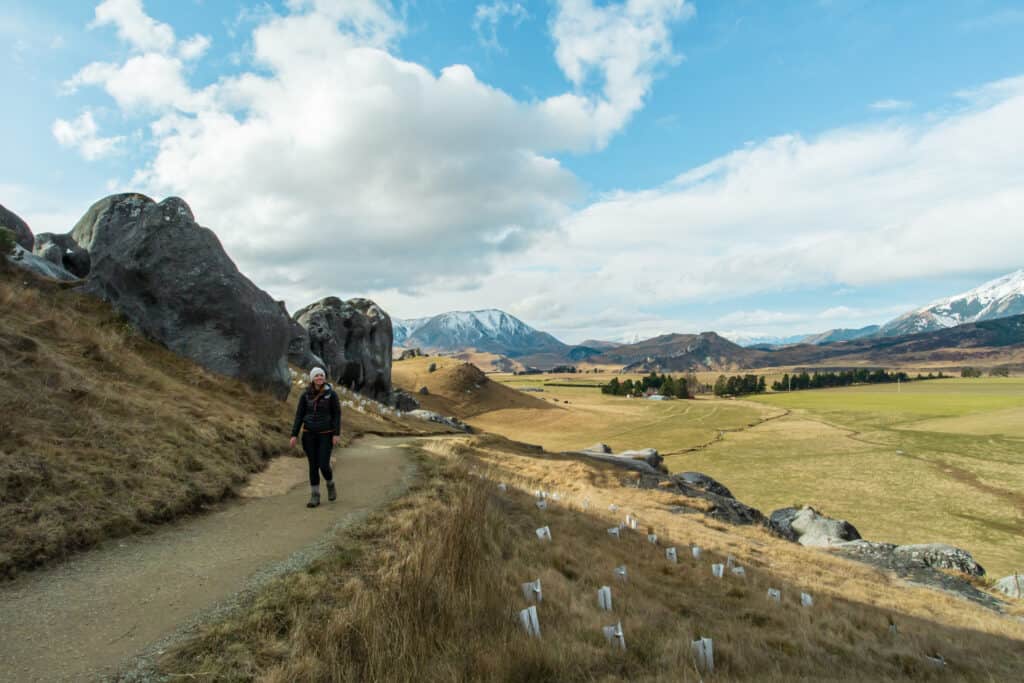
FULL HIKING GUIDE
Check out my full guide on how to walk the Kura Tawhiti Access Track.
Not only will you witness the impressive sight of giant limestone boulders (known as tors) against the backdrop of the Southern Alps, but keep your eyes peeled for unique flora and local wildlife sightings. There’s a myriad of photo opportunities, so your camera is a must-have on this adventure.
For an in-depth and complete guide about what the Kura Tawhiti Access Track has to offer, make sure to check out the full blog post here.
Cave Stream Scenic Reserve
Crawling through the 594-meter (1948ft) long limestone cave underneath nearby Flock Hill is an adventure taking about one to two hours, depending on water levels and group speed.
There are two short tracks from the carpark to the upstream (inlet) and downstream (outlet) entrances, each taking about 30 mins to walk. It’s recommended that you walk through the cave in an upstream direction, as this is easier for navigating the waterfalls along the route.
You must not enter the cave unless you are well-prepared with at least two reliable headlamps per person, warm clothes (polypropylene and/or merino), and sturdy footwear. This cave has claimed lives! The stream can be very cold and the rocks slippery.
Make sure to check the alerts for water levels & hazard risk on the DOC website before heading out. In places, the water is waist deep on adults (even when river levels are low). Don’t enter the cave after periods of heavy rain or if the river is in flood.
Bouldering at Castle Hill
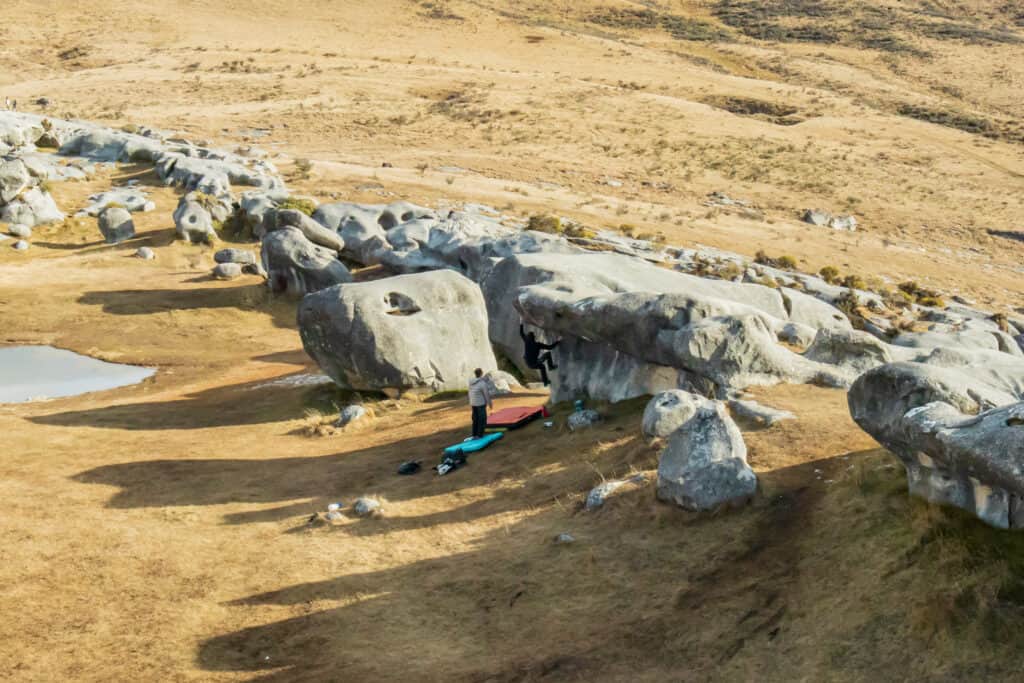
Castle Hill is a bouldering mecca, renowned throughout NZ for its remarkable limestone rock formations that offer climbers an exceptional array of problems to solve. Its popularity stems not just from the sheer volume and variety of boulders but also from its high friction rock that allows for dynamic moves.
Expect to encounter everything from slabs to overhangs, with classic problems that have been polished by the attempts of climbers over the years. There’s something to test every aspect of your climbing skills. Grades here range widely, allowing for progression from warm-ups to hard projects that might take more than a quick session to crack.
Check out CastleHillBasin.co.nz and ClimbNZ for more information about climbing & bouldering at Castle Hill.
About Castle Hill and the Kura Tawhiti Conservation Area.
Located on the South Island of New Zealand, Castle Hill is a small settlement known for its beautiful limestone rock formations. These towering boulders are surrounded by stunning natural landscapes, making it a popular destination for outdoor enthusiasts and adventure seekers.
Here’s some more about what to expect as you visit this area.
Castle Hill New Zealand History and Geology
The rocks at Castle Hill are made up of limestone rocks, mudstone, sandstone, and tuffs all formed from layers of organic sediment that settled in deep oceans. Over time, the layers were compressed into soft, soluble rock.
The area was once covered by a large, shallow inland sea that started filling up around 30 million years ago. As pressure built up, the landscape experienced uplift, folding, and faulting which created the Torlesse and Craigieburn Ranges.
Due to water erosion, the limestone rock was shaped into the distinct landforms that now make up this karst landscape.
🤔 DID YOU KNOW ❓
The limestone landscape is so unique that the nearby Flock Hill limestone area was used as a filming location for global blockbuster The Chronicles of Narnia: the Lion, the Witch and the Wardrobe!
Ngai Tahu Values
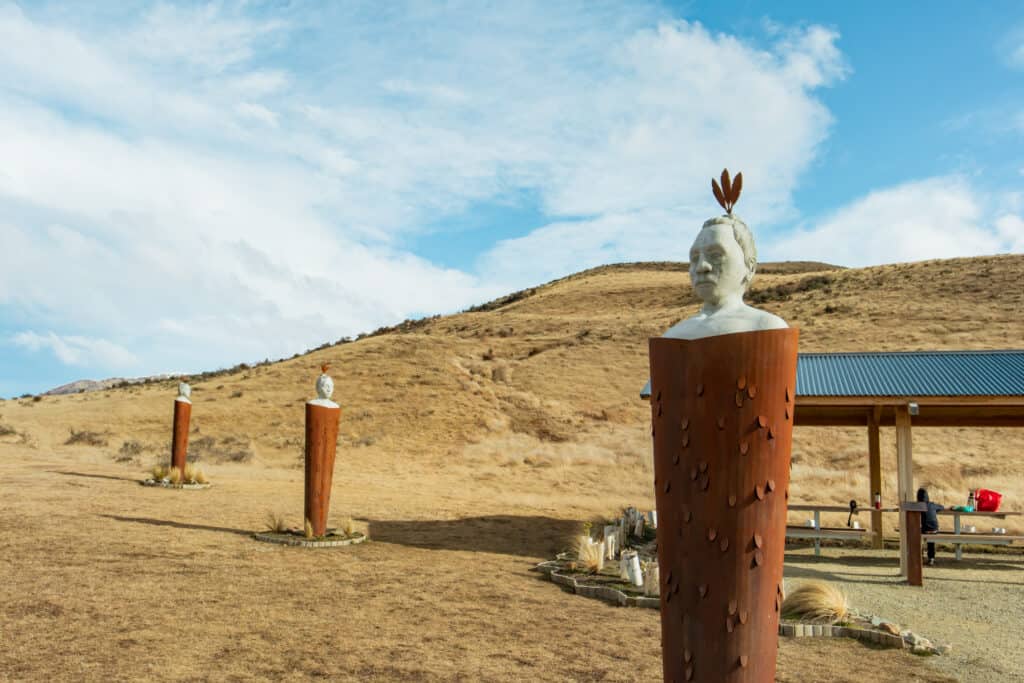
The Castle Hill area holds significant cultural importance for the Ngai Tahu tribe, who have a long history of living and farming in the region.
Kura Tawhiti literally translates to “the treasure from a distant land” referring to the kumara or sweet potato crop that was once cultivated and grew in abundance here.
It’s important for visitors to respect and honour Ngai Tahu values while exploring the area.
In recent years, DOC has worked closely with Ngai Tahu to implement conservation efforts in Castle Hill. This includes track maintenance, weed control, and protecting the fragile limestone formations from damage caused by climbing.
It’s important for visitors to follow Leave No Trace principles and stay on designated tracks to preserve the area for future generations. This includes not marking the surface of the rocks and respecting fenced-off areas. Climbers and boulderers should follow the climbing code of conduct at all times.
Unique Plants
Castle Hill is a sanctuary for some of Canterbury’s most unique and endangered flora. The landscape has undergone significant changes over the years, from fire 600 years ago to extensive grazing.
Now, it’s mostly covered in tussock and pasture, which creates a striking contrast to the once abundant tōtara and shrubland. There is still, however, one solitary tōtara tree remaining as a reminder of its lush past.
Castle Hill’s Lance McCaskill Nature Reserve was created specifically to safeguard the rare Castle Hill buttercup which only grows in this limestone landscape. Established in the 1950s, it was in fact New Zealand’s first plant reserve.
The reserve, spanning 6 hectares, safeguards these unique plants against threats like invasive weeds and poaching. It also supports other rare species like the Castle Hill forget-me-not, limestone wheatgrass and a small sedge.
Castle Hill Village
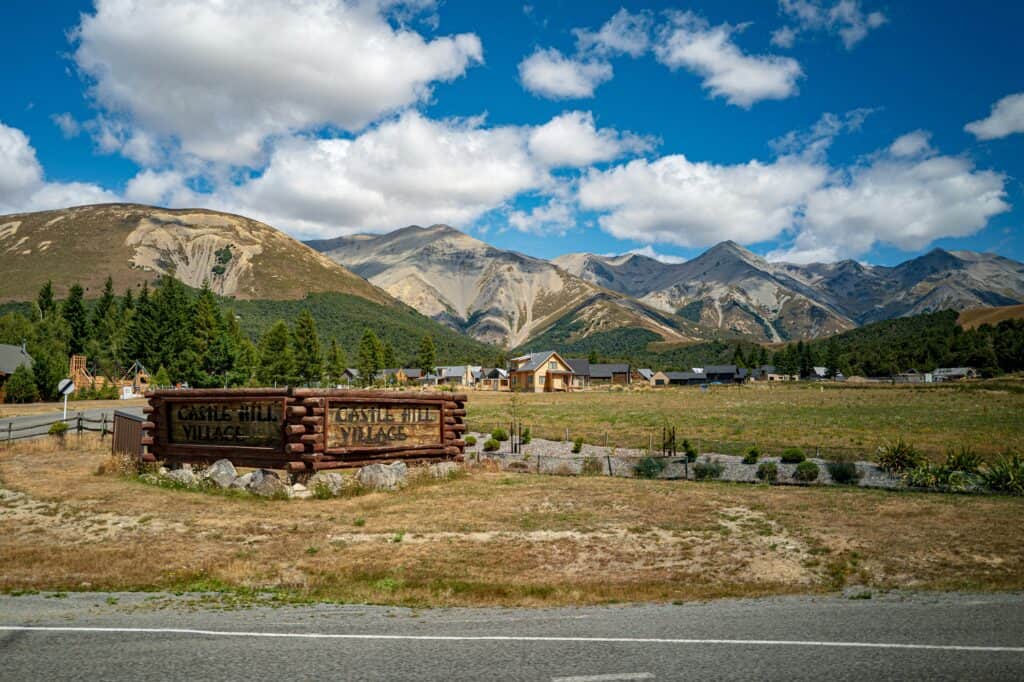
While the main attraction of Castle Hill is its natural beauty, the nearby village settlement also offers a charming and welcoming atmosphere for visitors wanting to explore and recreate in the Castle Hill basin.
There’s plenty to do here, with the nearby bouldering and rock climbing at Castle Hill just the beginning. The Craigieburn range is home to a number of hiking and tramping tracks (including the nearby Te Araroa trail), a growing network of mountain bike tracks on the Craigieburn Trails and plentiful fishing options.
In winter, there are four skifields located within a short distance of Castle Hill Village, with the closest being the Porters Ski Area.
The village has a small permanent population, being filled with mostly tourist accommodation for the surrounding skifields and outdoor activities.
Facilities
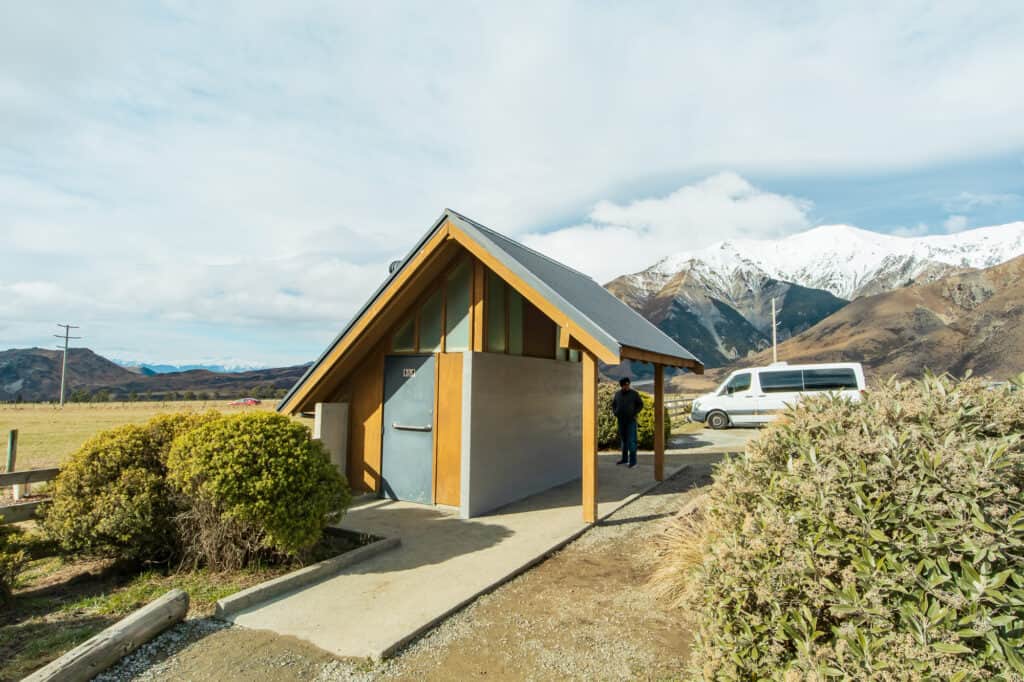
At the Castle Hill Conservation Area itself, DOC has provided a large carpark, covered picnic benches, a long drop toilet, and information boards for visitors to use. There is also a carpark and toilet at the Cave Stream Reserve.
Other facilities are very limited. The nearest cafes are at Springfield and Arthur’s Pass (both about a 35 minute drive) and the nearest supermarket is at Darfield. If you need petrol, then the closest petrol station is also at Springfield (there is no petrol at Arthur’s Pass).
Because most of the land surrounding Castle Hill is private, camping is not permitted anywhere outside of the Mistletoe Flats DOC campsite at Craigieburn.
Dogs Not Permitted
Unfortunately, due to the sensitive nature of the surrounding landscape, dogs and other domestic animals are not permitted in the Kura Tawhiti (Castle Hill) Conservation Area.
Where is Castle Hill New Zealand?
Castle Hill New Zealand Map
The Castle Hill Kura Tawhiti conservation area is located approximately 1 hour 20 mins west of Christchurch, New Zealand on State Highway 73.
SH 73 is the main road crossing the Southern Alps to the West Coast through Arthurs Pass, which is just 40 mins further along the road.
At an elevation of 750m / 2,460ft above sea level, and bounded by the Torlesse Range to the east and Craigieburn Range to the west, Castle Hill is located in an alpine basin and in winter snow can fall to road level.
There is very little shade or shelter in the Castle Hill basin so visitors should be prepared with warm and waterproof clothing in colder months, and long layers, sunscreen, hats and sunglasses in summer.
How to Get to Castle Hill.
The easiest way to get to Castle Hill is by private car. If you don’t have your own private vehicle, you can hire a rental car easily from Christchurch airport.
The road trip from Christchurch to Castle Hill takes 1 hour 20 mins.
Because State Highway 73 crosses alpine terrain, in winter it can be affected by snow and ice making driving conditions dangerous. However, being one of only two major east-west roads on the South Island, contractors work hard to keep the road open even during bad conditions.
Regardless, be prepared for delays and/or road closures in the winter months (June to August).
Local shuttle bus, East-West Coaches provides a shuttle to and from Christchurch Airport for $65 per adult each way. However, the shuttle only runs once per day so you’ll have to spend a night at Castle Hill Village to catch your return shuttle.
Alternatively, you can take a train to Arthur’s Pass and then consider hitchhiking to Castle Hill. State Highway 73 is a popular route and there is always plenty of traffic.
Accommodation Castle Hill NZ.
Castle Hill Village accommodation is a quaint and cozy alpine chalet experience in a village atmosphere.
Most holiday homes at Castle Hill Village include fully-equipped kitchens, comfortable living areas, and breathtaking views of the surrounding mountains (with a few even offering spa pools to relax and soak in those alpine vistas!).
Chalets can be hired with all budget ranges in mind, typically costing between NZD100 to almost NZD400 per night depending on the season and level of comfort/amenities provided. Browse all the options for Castle Village chalets here.
For a budget option that suits the adventure focussed, nearby Forest Lodge is a great place to base yourself for exploring the Castle Hill basin’s tramping tracks, mountain biking trails and climbing.
For an alternative option, consider Arthur’s Pass for additional lodging choices. Adventure-lovers will enjoy the wealth of walking tracks and scenery on offer here and in the surrounding Arthur’s Pass National Park.
Best time to Visit Castle Hill NZ.
Castle Hill, New Zealand, is a must-visit location any time of year!
The last time I visited was in August and the snow-capped tips of the Torlesse and Craigieburn Ranges were still hanging around! I wanted to stay for a whole weekend!
In winter (June to August), the snowy wonderland of Castle Hill and the nearby Porters Skifield offers beautiful photo opportunities and activities like cross-country skiing and snowboarding.
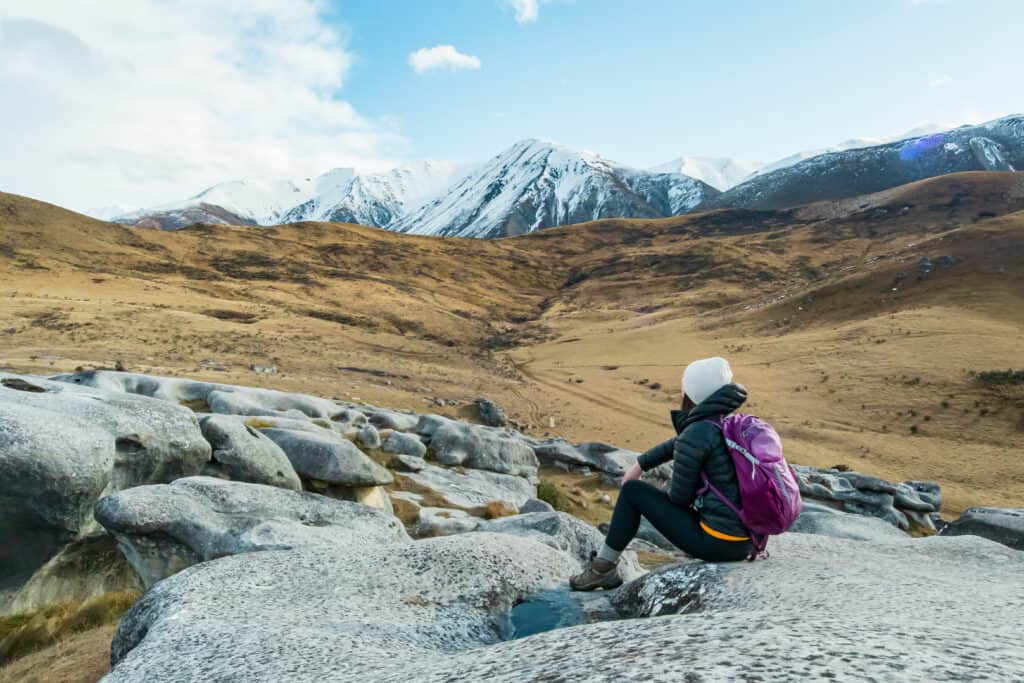
As winter fades, boulderers and climbers flock to Castle Hill in summer (December to February). With clear blue skies and stable weather, it’s the perfect time to explore the distinctive limestone formations and enjoy bouldering.
Summer offers scenic walking trails like the Kura Tawhiti Access Track, and Cave Stream scenic reserve as well as a growing network of mountain biking trails on the nearby Craigieburn Range!
Final Thoughts: Castle Hill New Zealand Travel Guide.
There is no doubt that Castle Hill, New Zealand, is a unique and special destination.
With its incredible limestone rock formations, easy walking tracks, stunning landscapes and access to the skifields of the Southern Alps, it’s the perfect place to easily escape the daily grind and connect with nature.
From adventurous bouldering to relaxing walks, picnic spots and alpine skiing, there’s something for everyone at Castle Hill.
